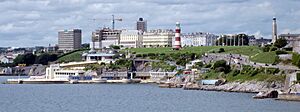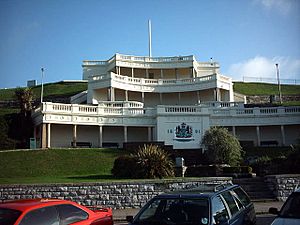Plymouth Hoe facts for kids
Plymouth Hoe, often called the Hoe by local people, is a big open public space in the city of Plymouth, England. It faces south towards the sea. The Hoe is located next to and above low limestone cliffs that form the coastline. From here, you can see amazing views of Plymouth Sound, Drake's Island, and across the Hamoaze to Mount Edgcumbe in Cornwall. The name "Hoe" comes from an old Anglo-Saxon word, hoh. This word means a sloping ridge that looks like an upside-down foot and heel.
History of Plymouth Hoe
John Lucas, sergeant, had 8d. for cutting Gogmagog.
For a long time, until the early 1600s, huge outlines of giants were carved into the grass of the Hoe. These giants were called Gog and Magog (or Goemagot and Corineus). When the grass was cut away, the white limestone underneath showed through. People would regularly re-cut and clean these giant figures. Today, there are no signs of them left. This carving likely remembered an old Cornish story. It was said to be the spot, called Lam Goemagot – the Giant's Leap, where the giant was thrown into the sea by a hero named Corin.
Plymouth Hoe is famous for a story about Sir Francis Drake. It's said that in 1588, he played a game of bowls here. He was waiting for the tide to change before sailing out with the English fleet to fight the Spanish Armada. This story might not be completely true, but it's a popular legend. You can see an old map of Plymouth from 1591 at the British Library.
A Tudor fortress once protected the narrow water passage between the eastern Hoe and Mount Batten. Some parts of the old granite and limestone cannon points are still there. However, in the late 1660s, after the king returned to power, a huge star-shaped stone fortress was built. This new fortress was called the Royal Citadel. It was built to protect the port. It also likely helped to show the townspeople who was in charge, as they had supported Parliament during the Civil War. The military still uses the Royal Citadel today.
From 1880, there was a popular bandstand on the Hoe where music was played. It was taken down for scrap metal during the Second World War and was never rebuilt. A three-story viewing platform, called a belvedere, built in 1891, is still there. It was built where a camera obscura used to be. That camera obscura was probably built in the 1830s and showed views of the harbor. Below this area was the Bull Ring, which is now a memorial garden. There was also a large pleasure pier, started in 1880. This pier had a dance hall, places to eat, and was a spot for walking and getting on boat trips. German bombs destroyed the pier during World War II.
To the west of the naval memorial, there is an impressive row of Victorian buildings. These buildings used to continue all the way to the Grand Hotel. They also went to the Royal Western Yacht Club's grand clubhouse, which was destroyed by bombing. The yacht club then joined with another club. It moved into older buildings before moving again in the late 1980s.
Famous Landmarks

A very well-known landmark on the Hoe is Smeaton's Tower. This is the top part of John Smeaton's Eddystone Lighthouse. The lighthouse was first built on the Eddystone Rocks, about 14 miles (23 km) south, in 1759. In 1877, it was taken apart, stone by stone. Then, it was moved and rebuilt on the Hoe.
Smeaton's Tower looks over Tinside Pool. This is a unique outdoor swimming pool from the 1930s. It sits on the limestone shoreline at the bottom of the cliff. Most of the work to create the swimming areas and Madeira Road was done to give jobs to local people who were unemployed during the Great Depression.
A statue of Sir Francis Drake, made by Joseph Boehm, was placed here in 1884. It's a copy of the original statue in his hometown of Tavistock. There are also several war memorials along the northern side of the Hoe. The biggest one remembers the Royal Naval sailors who died in the two world wars. Its main tall stone monument was designed by Robert Lorimer and was shown to the public in 1924. The garden around it was added by Edward Maufe in 1954. The Armada Memorial was opened in 1888. It celebrates 300 years since the Spanish Armada was defeated.
The Hoe also has a long, wide paved walkway. This walkway is currently used as a car park for disabled drivers. It serves as a great place for military parades. It is often used for shows by the Royal Navy, Royal Marines, and the Army. It also hosts travelling funfairs and outdoor concerts.
Inside the shape of the southern sea-facing walls of the Royal Citadel is the Citadel Hill Laboratory. This is part of the Marine Biological Association of the UK. It also houses the Sir Alister Hardy Foundation for Ocean Science. Below and to the east, on the rocky shore, is the clubhouse of the Royal Plymouth Corinthian Yacht Club.
Fun for Visitors
The Hoe is a popular spot for people from Plymouth and for tourists. There is always a lot happening on the water. You can often see warships moving, ferries traveling to and from France and Spain, and fishing boats. Many different sizes of sailing boats are also active. The Fastnet yacht race finishes here. Every year, the two-day British Firework Championships attracts thousands of people.
For 40 years, there has been discussion about building new things near the Hoe's green space. Two new hotel buildings have been put up. One is at the end of Armada Way, and the other is at the end of Leigham Street near the water. These modern buildings look very different from the old Victorian buildings around them. The old Grand Hotel has been turned into apartments. A modern block of flats now stands where the yacht club site used to be empty for a long time.
The Plymouth Dome was a building with a dome and towers. It was built into an old small quarry above Tinside. It was meant to be a tourist attraction about history. However, it didn't get enough money and closed in 2006, even though 2.3 million people had visited it. Between 2013 and 2016, it was a restaurant owned by the famous chef Gary Rhodes.




